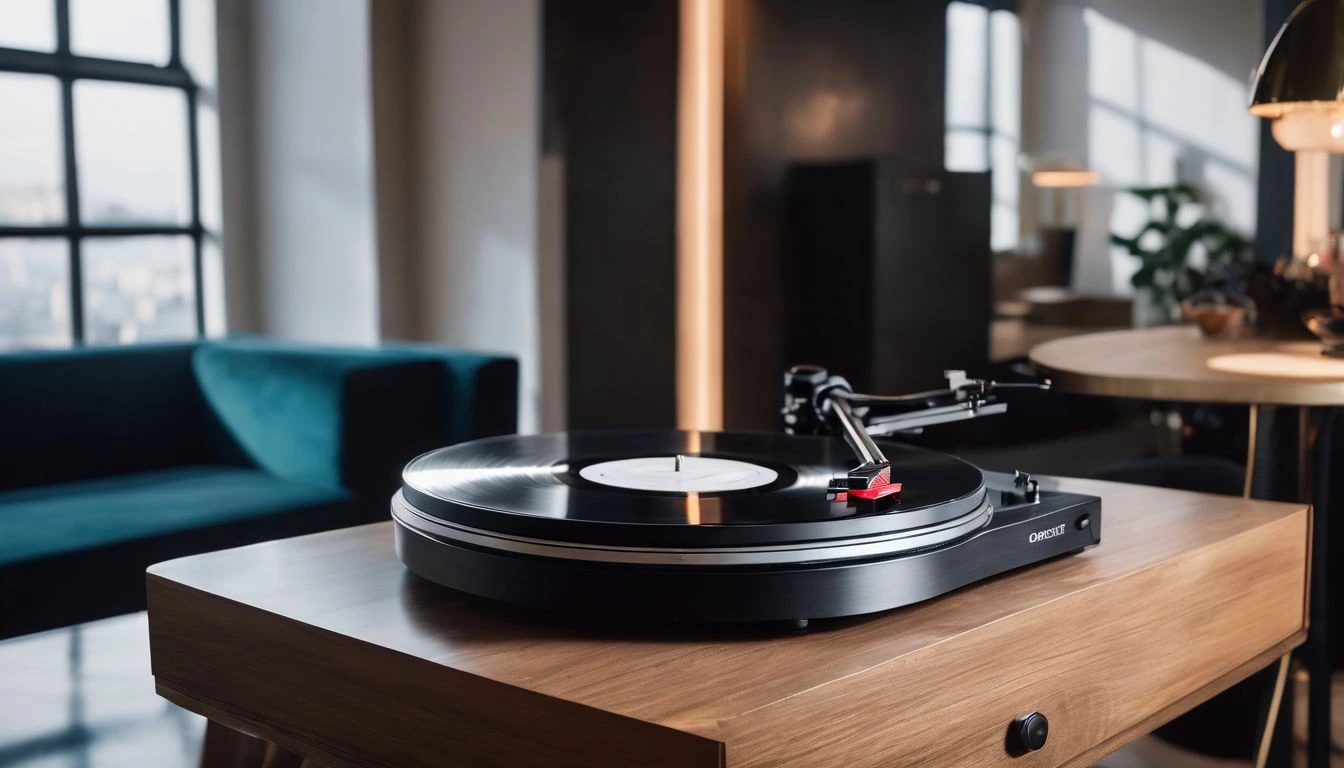Are your vinyl records not quite hitting the right notes? Speed is everything when it comes to turntables, often measured in revolutions per minute (RPM). This article will guide you through the simple steps needed to fine-tune your turntable speed, ensuring every spin hits that sweet spot.
Keep reading—perfect playback awaits!
Key Takeaways
- Your turntable can play at different speeds, like 33 ⅓ RPM for LPs and 45 RPM for singles. Adjusting the speed makes the music sound right.
- Use a strobe disc or an app to test your turntable’s speed. Small screws help adjust the RPM if it’s too fast or too slow.
- Regular cleaning and maintenance of your turntable prevent speed issues. This includes caring for the belt, stylus, and platter.
Understanding Turntable Speed
Understanding turntable speed is essential for any vinyl enthusiast looking to perfect their audio experience. It’s the pulse of your music, ensuring every note hits at just the right moment—whether you’re spinning classic long plays or the latest 45s, getting this right makes all the difference between mediocre and magnificent sound.
Different speeds for different needs
Record players come with two main speeds: 33 ⅓ RPM for long play (LP) albums and 45 RPM for singles. The size of the vinyl and the music’s length decide which speed you’ll need.
For example, a full album fits on an LP at a slower spin, while a single track spins faster to produce high-quality sound.
Belt-drive turntables use elastic belts to connect the motor to the platter where records sit. This setup reduces motor noise but can wear out over time. Direct-drive turntables link the motor directly to the platter, leading to quick starts and consistent speed.
Each design has its fans because they affect sound quality in different ways. Choose your turntable type based on what sounds best to you and how often you’ll use it.
Belt Drives Versus Direct Drives
Belt-driven turntables charm listeners with their natural sound. The rubber belt absorbs motor vibrations, keeping them away from the platter where your LPs spin. These belts do need some time to get up to full speed, which might affect quick-starting a song.
Direct-drive turntables are like sprinters—they jump into action fast! Their design connects the platter straight to the motor. This means there is no waiting around for the music to start.
But watch out—this setup can let motor buzz sneak into your speakers if it’s not top-notch quality.
How to Test Your Turntable’s Speed?
Testing your turntable’s speed is crucial for the best sound. You’ll need a strobe disc and a strobe light to get started.
- First, find a strobe disc online that matches your turntable speed—33 ⅓ or 45 RPM.
- Print the strobe disc out on paper and place it directly on your turntable’s platter.
- Remove the dust cover of your record player to prevent any reflection from skewing the test.
- Turn on your turntable and make sure it’s set to the correct RPM for the strobe disc you are using.
- Shine a strobe light onto the spinning strobe disc. The patterns should still appear if the speed is accurate.
- Look closely at the markings on the disc as they rotate. If they’re moving slowly forward, your turntable is running fast.
- Check if marks are drifting backward; this means your turnable spins too slowly.
- Adjust accordingly if you see movement, using this visual cue as guidance for perfect timing.
- Repeat these steps after making adjustments to ensure precision in speed settings.
Steps to Adjust the Turntable Speed
Navigating the intricacies of your turntable’s mechanics might sound daunting, but fear not—a steady hand and a little know-how can get those records spinning true to their intended speed.
With just a few tweaks under the hood, you’ll be all set to fine-tune your player for pitch-perfect playback; let’s roll up our sleeves and dial it in!
Identifying Speed Adjustment Screws
Look for small screws on your turntable. These are the speed adjustment screws. They might be labeled with “33” and “45,” which stand for different rpm settings. DJs often use turntables with strobe lights to help find these screws.
Use a flat-head screwdriver to adjust them. Turn left or right to slow down or speed up the platter’s rotation. Check your manual if you’re not sure where the screws are located.
Adjusting speed with screws
Now that you’ve located the speed adjustment screws, it’s time to fine-tune your turntable. These screws control the rpm, ensuring your records play at just the right pace. Here’s how to do it:
- Turn off and unplug your turntable before making any adjustments. Safety comes first.
- Locate the access points for the potentiometers, usually beneath the platter or on the base of the unit.
- Use a small screwdriver to gently adjust these screws. A tiny turn can make a big difference.
- Turn on your turntable and play a record to check if the speed is correct. Listen closely for any changes.
- If you have a stroboscopic disc or an app, use it now. They help you see if the record spins at the right speed.
- Adjust again if needed. It might take a few tries to get it perfect.
- Keep playing and adjusting until your records sound great at both 33 and 45 rpm.
Checking Speed After Adjustment
After adjusting the speed of your turntable, you need to check if it’s spinning at the right RPM. Make sure your records sound just how they should by following these steps:
- Use a strobe disc to test the speed. Place it on the platter and watch the pattern under good light. It should still appear if the speed is correct.
- Try out the ‘RPM Speed & Wow‘ mobile app for another method. It listens to your turntable and tells you the spinning speed.
- Listen carefully to the music. If it sounds too high-pitched or too low, some further tweaking might be needed.
- Look at how your turntable starts and stops. If it takes longer than usual or stops too soon, there may be a problem.
- Compare it with a digital track. Play a song you know well digitally and then on vinyl to see if they match.
What to Do If Your Turntable Speed is Off?
If your tunes aren’t spinning quite right and the tempo’s off, don’t fret—we’ve got the remedies to fine-tune that turntable speed back to its perfect pitch. Keep reading for our harmonious solutions!
When Your Record Player is Lagging Behind?
Is your record player moving too slowly? It might be spinning below the right speed. This means your music won’t sound as it should. RPM, or revolutions per minute, tells you how fast your records need to spin.
If a song sounds draggy or books on tape play too slowly, check the rpm.
You can fix a lagging turntable with a few steps. First, find out the correct rpm for your record. Most will use either 33 1/3, 45, or 78 rpm. Use a strobe disc or an app to test the current speed of your turntable.
Once you know it’s off track, look for small screws that adjust speed—usually under the platter or near the motor. Turn them slightly and recheck with your tool until it matches what’s needed for smooth listening!
When Your Record Player Is Jumping Ahead?
Your record player might start playing too fast, causing it to jump ahead. This means it’s spinning quicker than the right speed. If this happens, you’ll want to fix it so your music sounds good again.
Check if your turntable has a pitch control or fine-tuning adjustment. Use these controls to slow down the RPM until the music plays at the correct pace. You can also use a strobe disc or an app on your phone to make sure the speed is just right.
If adjusting doesn’t work, look inside your player for dust or dirt that might be messing with the motor or belt. Clean these parts carefully and try adjusting them again. Sometimes belts get old and stretched out; replacing them can often fix jumping issues and bring back perfect tunes!
Troubleshooting a Repeating Record Issue
A repeating record is like a stuck car wheel; it just won’t go forward! The fix might be simpler than you think. Check the turntable’s belt first; a loose or worn belt often causes repeats.
Gently lift the platter and inspect the belt. If it’s stretched out or has lost its grip, it’s time for a new one. It might cost between $30 and $40 if you want a pro to handle this.
Sometimes, debris on your turntable can play tricks on you. A speck of dust under the needle makes records skip or repeat. Grab a soft brush and give your turntable a good clean-up! Delicately remove any dirt from under the stylus too; that tiny thing controls everything your ears love about vinyl music.
Maintaining Your Turntable’s Speed
Keeping your turntable spinning at the right speed isn’t a one-and-done task—it’s an ongoing commitment. Regular upkeep not only preserves the flawless playback of your favorite vinyl, but it also prolongs the life of your cherished record player.
Regular maintenance tips
Turntables need care to keep playing music smoothly. Taking good care of your record player helps it last longer.
- Use a soft, anti-static brush to gently clean your records before and after each use. Dust and dirt can scratch records and damage the needle.
- Wipe down the turntable with a dry cloth. Keep it free from dust that can settle into important parts.
- Check the belt on a belt-drive turntable regularly for signs of wear or looseness.
- For direct-drive models, listen for any changes in sound quality that might suggest internal issues.
- Handle the tonearm with care. Always use the cueing lever to raise and lower it to avoid damaging the stylus or records.
- Replace the stylus as needed. Most manufacturers recommend doing this every 1,000 hours of playtime.
- Balance the tonearm using a tracking force gauge to ensure it’s not too heavy or light on your records.
- Make sure you store vinyl records upright and in a cool, dry place to prevent warping.
- Invest in a high-quality dust cover to shield your turntable from airborne particles when not in use.
Keeping Your Plate Turning Like Clockwork
A smooth-running turntable is key to enjoying your vinyl collection. Take care of it with regular maintenance, and you’ll avoid common speed problems. Use a dust cover to keep particles away from the platter and needle.
This simple step can prevent many issues before they start.
Clean your turntable often, but gently, using products made for this purpose. A bit of oil on moving parts keeps everything spinning without friction. Consider taking your turntable for a professional check-up every couple of years—it’s like a tune-up for your car! These habits will make sure that the RPM stays consistent and that each record plays just as intended.
Conclusion
Keep your turntable spinning right, and your music will sound its best. Whether it’s a simple tightening of a screw or seeking professional assistance, keep in mind that you’ve got this! Just stick to those maintenance routines, and you’ll enjoy flawless vinyl play every time.
Ready to groove? Get started with that perfect speed adjustment today!
For more insights on resolving specific playback issues, check out our detailed guide on why your record might be repeating.
FAQs
What’s the right speed for my turntable?
Turntables play records at different speeds, measured in RPM—revolutions per minute. Most records spin at either 33 1/3, 45, or sometimes even 78 RPM.
How do I change my turntable’s speed?
Look for a switch or knob on your turntable marked with speeds—like “33” and “45.” Simply flip the switch or turn the knob to select your record’s needed RPM.
My music sounds too fast or slow; what should I do?
If the music’s tempo seems wrong, check that you’ve set your turntable to match the record’s labeled RPM. If it’s still off, adjust until it sounds just right!
Can adjusting speed damage my records or turntable?
No worries—changing speeds won’t harm your gear! Turntables are built to let you swap between settings safely, so you can enjoy all your favorite tunes.


